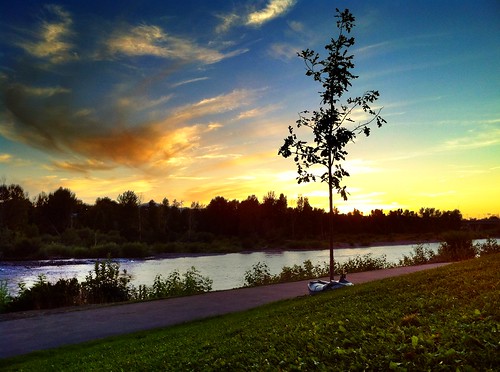If you own an iOS device and have not yet given the amazing videography app Hyperlapse a try, consider this post your official invitation and challenge. According to the English WikiPedia:
Hyperlapse (also walklapse, spacelapse, stop-motion time-lapse, motion timelapse, moving timelapse) is an exposure technique in time-lapse photography, in which the position of the camera is being changed between each exposure in order to create a tracking shot in timelapse sequences. In opposite to a simple motion timelapse – dolly shots, which are realized with short camera sliders; in hyperlapse photography, the camera is being moved through very long distances.
Rather than explain it in words, it’s best to experience a Hyperlapse video visually. You can find far more compelling examples online, but these are two Hyperlapse videos I created this week for fun. The thing which makes the Hyperlapse so powerful is the way it uses the iOS accelerometer to digitally remove jitter so you end up with a fairly smooth final video, even if you don’t use a tripod or equipment for a true “dolly shot.”
My first effort was a 15 minute process of readying 31 computers in our school computer lab for students to start introductory lessons with MinecraftEDU. The final “hyperlapsed” version is 1.5 minutes long. I used an iPad and tripod, and didn’t have a wide enough angle lens to capture the entire computer lab… so I’m out of the frame for quite a bit. This doesn’t make for a super-engaging Hyperlapse video. I wanted to document, however, the extensively LONG process of getting all our computers in the lab ready for a lesson. I added some copyright-friendly music to this video before uploading with the free iOS app from Google, “YouTube Capture.”
The first year I taught STEM in Yukon, Oklahoma, I naively had my 4th and 5th grade students login to our Windows-based computers using their unique userIDs and passwords. I say “naive” because I later discovered there is functionally no advantage to our students doing this: They don’t have network “drives” on which they can save files, and their Windows authentication credentials are not “passed on” to any websites or software programs we utilize. Certainly it’s valuable for students to learn how to remember and use a userID and password, and it’s amazing to see how many students at the start of the year don’t know how to use the SHIFT key properly. Students can practice those things by logging in. Inevitably, however, requiring each class of students to log into the network wastes at least 5-10 minutes of each lesson for most students, and more time for others who flounder and flail trying to log in successfully. I’ve found that although it takes awhile (it used to be more like 20-25 minutes, now I can do it in about 15) this time investment pays instructional dividends. My students will learn about and practice using the shift key, right mouse button, and other “basics” of keyboard computing using our classroom KidBlogs for interactive writing. Instead of having students log in with unique userIDs and passwords, I use a “generic” login created by our IT department. I do wish this process was even faster, but I’m so thankful of many other things which make these steps seem like a mere trifle. IT functionality I’m thankful for in our computer lab includes:
- Fast and reliable Internet access
- Computers which are malware free and generally speedy
- Updated operating systems (we’ve used Win7 since 2013-14)
- Fast response time (within a day) for computers which have problems
- IT staff which are fully supportive of Java installs for MinecraftEDU software
My second Hyperlapse experiment is also 1.5 minutes long in finished form, but is a 12X compression of an approximately 20 minute commute from central Oklahoma City up Western Avenue to the northwest part of town. As Anthony Purcell commented on Instagram after I shared a clip of this on Twitter, “the stopping was scary!”
These two examples are not the most amazing hyperlapse videos you’ll find online, but they were both easy and fun to create! The app is free and it’s available for iOS only. You can record up to 45 minutes of video and make a single Hyperlapse version, choosing to compress frames up to 12 times. If you give it a try please share your creation online and tweet me a link, I’d love to check out what you create! I can’t wait to “take Hyperlapse on the road” to some interesting places and enjoy this new version of visual, digital documentation!
To learn more about “quick edit videography,” check out resources on Mapping Media to the Curriculum. I’ve added Hyperlapse as a recommended app there. Hyperlapse joins Pro HDR, YouTube Capture and Bubbli on my current list of favorite iPhonography / videography apps. To find out why I include Bubbli on this list, check out the panorama of the USAFA chapel I took with the app on my iPhone this past fall. Click and drag to pan. I love iPhoneography – so much power in our pockets!


